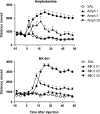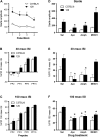Modeling the positive symptoms of schizophrenia in genetically modified mice: pharmacology and methodology aspects
- PMID: 19900963
- PMCID: PMC2833124
- DOI: 10.1093/schbul/sbp132
Modeling the positive symptoms of schizophrenia in genetically modified mice: pharmacology and methodology aspects
Abstract
In recent years, there have been huge advances in the use of genetically modified mice to study pathophysiological mechanisms involved in schizophrenia. This has allowed rapid progress in our understanding of the role of several proposed gene mechanisms in schizophrenia, and yet this research has also revealed how much still remains unresolved. Behavioral studies in genetically modified mice are reviewed with special emphasis on modeling psychotic-like behavior. I will particularly focus on observations on locomotor hyperactivity and disruptions of prepulse inhibition (PPI). Recommendations are included to address pharmacological and methodological aspects in future studies. Mouse models of dopaminergic and glutamatergic dysfunction are then discussed, reflecting the most important and widely studied neurotransmitter systems in schizophrenia. Subsequently, psychosis-like behavior in mice with modifications in the most widely studied schizophrenia susceptibility genes is reviewed. Taken together, the available studies reveal a wealth of available data which have already provided crucial new insight and mechanistic clues which could lead to new treatments or even prevention strategies for schizophrenia.
Figures


Similar articles
-
Enhanced dopamine function in DISC1-L100P mutant mice: implications for schizophrenia.Genes Brain Behav. 2010 Oct;9(7):777-89. doi: 10.1111/j.1601-183X.2010.00615.x. Epub 2010 Aug 12. Genes Brain Behav. 2010. PMID: 20618446
-
Prepulse inhibition of the startle reflex: a window on the brain in schizophrenia.Curr Top Behav Neurosci. 2010;4:349-71. doi: 10.1007/7854_2010_61. Curr Top Behav Neurosci. 2010. PMID: 21312406
-
Cholinergic Neurons of the Medial Septum Are Crucial for Sensorimotor Gating.J Neurosci. 2019 Jun 26;39(26):5234-5242. doi: 10.1523/JNEUROSCI.0950-18.2019. Epub 2019 Apr 26. J Neurosci. 2019. PMID: 31028115 Free PMC article.
-
Using an animal model of deficient sensorimotor gating to study the pathophysiology and new treatments of schizophrenia.Schizophr Bull. 1998;24(2):285-301. doi: 10.1093/oxfordjournals.schbul.a033326. Schizophr Bull. 1998. PMID: 9613626 Review.
-
Sensorimotor gating of the startle reflex: what we said 25 years ago, what has happened since then, and what comes next.J Psychopharmacol. 2016 Nov;30(11):1072-1081. doi: 10.1177/0269881116661075. Epub 2016 Aug 18. J Psychopharmacol. 2016. PMID: 27539931 Free PMC article. Review.
Cited by
-
Acute N-methyl-D-aspartate receptor hypofunction induced by MK801 evokes sex-specific changes in behaviors observed in open-field testing in adult male and proestrus female rats.Neuroscience. 2013 Jan 3;228:200-14. doi: 10.1016/j.neuroscience.2012.10.026. Epub 2012 Oct 22. Neuroscience. 2013. PMID: 23085219 Free PMC article.
-
A conceptual and practical guide to the behavioural evaluation of animal models of the symptomatology and therapy of schizophrenia.Cell Tissue Res. 2013 Oct;354(1):221-46. doi: 10.1007/s00441-013-1611-0. Epub 2013 Apr 12. Cell Tissue Res. 2013. PMID: 23579553 Free PMC article. Review.
-
Effect of tandospirone, a serotonin-1A receptor partial agonist, on information processing and locomotion in dizocilpine-treated rats.Psychopharmacology (Berl). 2010 Oct;212(2):267-76. doi: 10.1007/s00213-010-1951-3. Epub 2010 Jul 31. Psychopharmacology (Berl). 2010. PMID: 20676611
-
Habituation and prepulse inhibition of acoustic startle in rodents.J Vis Exp. 2011 Sep 1;(55):e3446. doi: 10.3791/3446. J Vis Exp. 2011. PMID: 21912367 Free PMC article.
-
Map2k7 Haploinsufficiency Induces Brain Imaging Endophenotypes and Behavioral Phenotypes Relevant to Schizophrenia.Schizophr Bull. 2020 Jan 4;46(1):211-223. doi: 10.1093/schbul/sbz044. Schizophr Bull. 2020. PMID: 31219577 Free PMC article.
References
-
- Allen NC, Bagade S, McQueen MB, et al. Systematic meta-analyses and field synopsis of genetic association studies in schizophrenia: the SzGene database. Nature. 2008;40:827–834. - PubMed
-
- Arguello PA, Gogos JA. Modeling madness in mice: one piece at a time. Neuron. 2006;52:179–196. - PubMed
-
- Chen J, Lipska BK, Weinberger DR. Genetic mouse models of schizophrenia: from hypothesis-based to susceptibility gene-based models. Biol Psychiatry. 2006;59:1180–1188. - PubMed
-
- Desbonnet L, Waddington JL, O'Tuathaigh CM. Mutant models for genes associated with schizophrenia. Biochem Soc Trans. 2009;37:308–312. - PubMed
-
- Desbonnet L, Waddington JL, O'Tuathaigh CMP. Mice mutant for genes associated with schizophrenia: common phenotype or distinct endophenotypes? Behav Brain Res. 2009;204:258–273. - PubMed
Publication types
MeSH terms
Substances
LinkOut - more resources
Full Text Sources
Other Literature Sources
Medical

